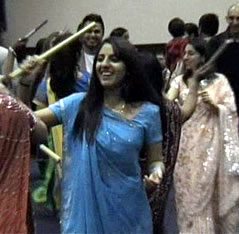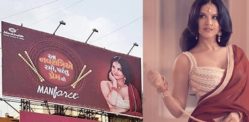Navratri holds immense importance in Indian culture.
Navratri is one of the most celebrated festivals in India.
The word, ‘Navratri’ comes from the Sanskrit words ‘nava,’ and ‘ratri,’ meaning ‘nine’ and ‘night’ respectively.
The festival spans nine nights and is dedicated to worshipping different forms of the Indian spiritual being, Durga.
It symbolises the triumph of good over evil.
Navratri is a celebration of feminism, devotion, and righteousness.
Most people know Navratri as a festival of dance, music, and colours. But why do we celebrate it?
Let’s learn about the history and significance of Navrati with DESIblitz.
Origins
 The origins of Navratri are rooted in ancient mythology and tradition.
The origins of Navratri are rooted in ancient mythology and tradition.
Navratri celebrates the battle between Durga and the buffalo demon, Mahishasura.
It is believed that Mahishasura had gained immense power through blessings from Brahma and became a tyrant.
In response to his reign of terror, a fierce force of feminine was created in the form of Durga.
Durga, with her multiple arms and riding a lion, fought Mahishasura.
After nine days of battle, Durga finally defeated Mahishasura on the tenth day.
This is known as Vijayadashami or Dussehra, restoring peace.
In earlier times, Navratri coincided with the post-monsoon harvest season, giving it both agricultural importance.
Farmers thanked Durga for a bountiful harvest and prayed for future prosperity.
Over time, this evolved into a festival with a strong focus on devotion and female empowerment.
Types of Navratri
 Navratri is celebrated four times a year.
Navratri is celebrated four times a year.
These four Navratris are Chaitra Navratri, Sharad Navratri, Magha Navratri, and Ashada Navratri.
Sharad Navratri, which falls between September and October, is the most popular one.
Let’s delve into them in detail.
Chaitra Navratri
This falls in the month of Chaitra (March–April).
Chaitra Navratri marks the beginning of the New Year in some regions.
It is especially popular in North India, coinciding with the festival of Ram Navami.
Chaitra Navratri is one of the most significant Navratris alongside Sharad Navratri.
Many people fast during these nine days, offering prayers for prosperity and well-being.
Sharad Navratri
This form falls between September and October.
It takes place in the month of Ashwin and concludes with Dussehra.
Sharad Navratri marks the transition from summer to autumn and is the most vibrant and festive of the four forms.
The nine days of this Navratri are filled with fasting, cultural festivities, and dances like Garba and Dandiya.
The nine avatars of Durga, known as Navadurga, are celebrated during this festival.
Magha Navratri
Magha Navratri is celebrated in January and February.
It occurs during the month of Magha and is mainly observed in the northern and eastern regions.
The emphasis during this period is on spiritual practices and cleansing of the soul.
Ashada Navratri
Ashada Navratri is celebrated in June to July.
It takes place during the monsoon season in the month of Ashada.
Like Magha Navratri, it is not as widely recognised but is observed in some regions as a time for deep devotion and meditation.
It is especially significant for Tantric practices in some parts of India.
Garba and Dandiya
 In Gujarat and Maharashtra, Navratri is synonymous with vibrant dance forms like Garba and Dandiya Raas.
In Gujarat and Maharashtra, Navratri is synonymous with vibrant dance forms like Garba and Dandiya Raas.
People gather in large numbers in open grounds, wearing colourful traditional attire.
The women glisten in lehengas or chaniya cholis while men shine in kurtas and turbans.
The energetic and rhythmic movements of Garba are performed in circular motions, often around an idol or image.
Dancers, mostly women, dress in colourful traditional attire, often featuring mirror work and intricate embroidery.
The dance involves rhythmic clapping and circular movements, often accompanied by traditional folk music.
The lively beats create an infectious atmosphere, encouraging everyone to join in the festivities.
Garba symbolises the devotion of devotees towards the goddess, representing both worship and celebration.
Dandiya, on the other hand, is often referred to as ‘Dandiya Raas.’
This dance is characterised by the use of decorative sticks, or ‘dandiya.’
This involves dancers rhythmically tap against each other while moving in pairs.
The vibrant costumes worn by participants add to the festive spirit, and the dance typically showcases both skill and togetherness among the dancers.
Dandiya is often performed at night and serves as a lively social gathering where people come together to celebrate, bond, and enjoy the festive spirit of Navratri.
These dance forms are accompanied by songs, folk music, and modern beats, creating an infectious festive atmosphere.
The spirit of community and devotion is evident as people of all ages come together, dancing late into the night.
Garba nights and Dandiya events are a highlight of Navratri.
Durga Puja
 In West Bengal, Navratri is celebrated as Durga Puja, which is a five-day grand festival dedicated to Durga.
In West Bengal, Navratri is celebrated as Durga Puja, which is a five-day grand festival dedicated to Durga.
Huge, elaborately designed pandals are erected, housing magnificent idols of Durga, along with her children.
The pandals are often themed, with intricate decorations, artistic displays, and lights attracting large crowds.
Durga Puja in Bengal is as much a cultural festival as it is a religious one.
It features cultural performances, music, and dance, as well as community feasts.
The offering of flowers and the evening aartis are key rituals.
It is followed by the immersion of the Durga idols on the last day.
The immersion process is a colourful affair, with processions through the streets, accompanied by drummers, dancing, and chanting.
Dussehra Celebrations
 The culmination of Navratri is Vijayadashami, or Dussehra. As mentioned previously, this takes place on the final day.
The culmination of Navratri is Vijayadashami, or Dussehra. As mentioned previously, this takes place on the final day.
While Navratri focusses on Durga’s battle, Dussehra celebrates the victory of good over evil.
In the northern parts of India, particularly in states like Uttar Pradesh and Delhi, Dussehra is marked by the dramatic performance of Ram Leela.
Ram Leela is an enactment of the life of Rama, focussing on his victory over Ravana.
In South India, the Ayodhya Puja features tools and instruments.
The day symbolises new beginnings and reminds people to cultivate goodness.
Alankaras and Kalash Sthapana
 During Navratri, Durga is celebrated in different Alankaras (forms or adornments) each day.
During Navratri, Durga is celebrated in different Alankaras (forms or adornments) each day.
In many South Indian temples, she is adorned in different clothes, jewels, and flowers.
This represents her various aspects, such as Shailaputri, Brahmacharini, and Chandraghanta, among others.
The rituals are performed with passion and people throng the temples to participate in the proceedings.
In homes, people set up Kalash Sthapana as part of the ritual.
It involves placing a sacred pot filled with water, topped with mango leaves and a coconut, symbolising the presence of Durga.
This Kalash is celebrated throughout Navratri, and it is believed to bring prosperity and peace to the household.
Fasting
 Fasting is a very important part of Navratri.
Fasting is a very important part of Navratri.
It is known as a means of cleansing the soul and detoxifying the body during this period. This also promotes self-discipline.
People often observe strict fasts, consuming only fruits, milk, and select grains.
Many follow a vegetarian diet while also avoiding alcohol and certain spices.
The meals are often simple, vegetarian, and free from grains like wheat and rice.
Instead, alternatives such as buckwheat flour, water chestnut flour, and amaranth are used.
Tapioca pearls are a common ingredient, often made into dishes like sabudana khichdi or sabudana vada.
Potatoes, sweet potatoes, and pumpkin are frequently cooked in light spices, offering nourishment without violating fasting rules.
Dairy products like milk, paneer, and curd are also popular during Navratri meals.
Many households prepare special desserts like kheer made with sabudana or fox nuts.
Sweets like laddoos made from coconut or singhara flour are also prominent.
Each day is dedicated to a different form of Durga, and specific rituals are performed to honour her manifestation.
In many households, idols or images of Durga are placed in a clean, decorated space, where people offer flowers, fruits, and sweets.
Clothes
 During Navratri, traditional and colourful clothing plays a significant role in the celebrations.
During Navratri, traditional and colourful clothing plays a significant role in the celebrations.
People often wear vibrant outfits to honour the goddess and participate in festivities.
In many regions, women wear lehenga cholis, sarees, or salwar kameez in bright colours including red, yellow, green, and blue.
These clothes are often adorned with intricate embroidery, mirrors, and embellishment.
The outfits feature traditional embroidery and mirror work.
They are often paired with colourful dupattas and stoles.
Each day of Navratri is associated with a specific colour. Hence, many people wear clothes in the designated colour for that day.
This reflects the mood and significance of the celebration.
Navratri is more than just a religious festival.
It is a time of community bonding, celebration of culture, and spiritual reflection.
The festival brings together people from all walks of life to honour Durga and celebrate the eternal victory of light over darkness.
Navratri holds immense importance in Indian culture. It’s a time for spiritual reflection, self-discipline, and renewal.
The festival also emphasises the cyclical nature of life, reminding us of renewal, growth, and transformation.
These celebrations reinforce the importance of faith and harmony in everyday life.
Navratri encourages people to reflect on their inner strength, helping them overcome personal challenges with grace and perseverance.






























































